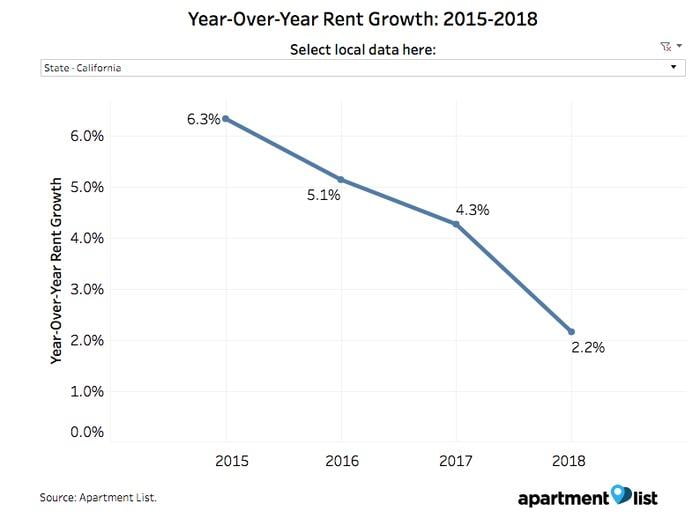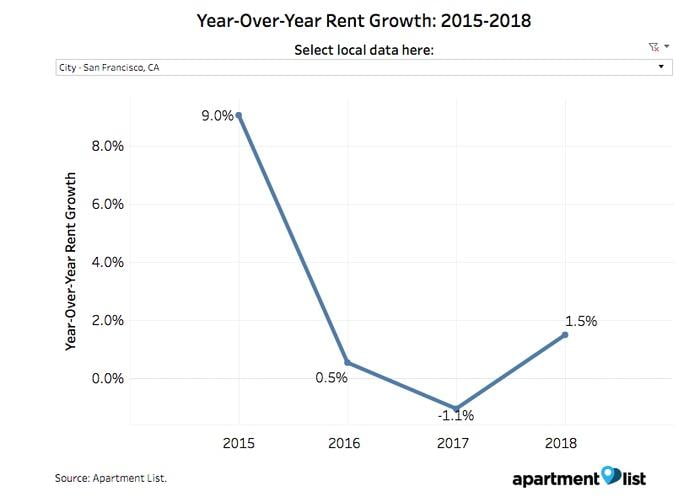Rent growth in California has slowed dramatically over the past three years according to recent data from Apartment List, a rental listing website. In June of 2015, California’s median rents were growing at a rate of 6.3% year-over-year. But current data shows that in June 2018, rents had grown just 2.2% year-over-year.

This trend is not unique to California, with nationwide rent growth currently standing at a rate of 1.5% (down from 3.6% in June of 2015). While the national median rent is still increasing, the rate of growth has been gradually decreasing over the past three years, with the biggest drop occurring over the past year.

At the national level, the sluggish rent growth can be partially attributed to an increase in the supply of new multi-family housing. In fact, cities with the highest multi-family construction spending per-capita, like Seattle, Denver and Portland, are currently showing some of the lowest rates of rent growth (-0.9%, +1.3% and -2.2%, respectively).
This correlation exists in California as well. Of California’s major cities, San Diego, San Francisco and San Jose had the highest per-capita spend on multi-family construction in 2016. Current year-over-year rent growth in those cities stands at 1.8%, 1.5% and 2.2%, respectively. The surge in multi-family housing construction has not only kept rents from soaring but also serves to alleviate the housing shortage and boost local economies.
Let’s take a closer look at which California cities have seen the biggest decline in annual rent growth.
Bay Area Rent Growth Trends

As a whole, the Bay Area has experienced some of the most significant decreases in rent growth since 2015:
- In 2015, median rents in San Jose increased7% year-over-year. Today, rent growth stands at a modest 2.2% year-over-year.
- San Francisco rent growth rates have declined sharply over the past three years, from a high of 9.0% year-over-year in 2015. In 2017, San Francisco rents actually decreased by 1.1%, but in 2018 rent growth has increased to +1.5%.
- Rent growth in Oakland experienced a dramatic drop from +8.9% in 2015 to -0.4% just 12 months later. Rent growth is beginning to increase again and currently stands at 4.5% year-over-year.
Orange County Rent Growth Trends

Major cities in Orange County have also experienced notable slowdowns in rent growth:
- Rent growth in Santa Ana has fluctuated over the past three years. Year-over-year growth currently stands at 1.2%, down from 6.2% in 2015.
- Anaheim year-over-year rent growth remained high from 2015-2017 but dropped down to 2.2% in 2018.
- Irvine year-over-year rent growth slowed from 5.0% in 2015 to 2.3% in 2018.
LA Metro Rent Growth Trends

Two major cities in the Los Angeles metro area have experienced similar decreases in year-over-year rent growth:
- Los Angeles rent growth has experienced a decline of 3.6 percentage points over the past three years. Rent growth is currently at 1.9%, compared to 5.5% in 2015.
- Current rent growth in Long Beach stands at 2.2%. Year-over-year rent growth was previously at 5.6% in 2015 but was as high as 9.6% in June of 2016.
Rent Growth in Other Major California Cities

- Of California’s 10 largest cities, Fresno is the only one to experience an increase in the rate of rent growth over the last three years. Rent growth there is currently 2.9% year-over-year, up from 1.8% in 2015.
- Sacramento rents were some of the fastest growing in the country, at 7.4% year-over-year in 2017, but rent growth slowed significantly in 2018.
- In 2015, rent growth in Riverside stood at 5.9%; today growth has dropped to 2.9% year-over-year.
- In San Diego, annual rent growth slowed each year from 2015-2018. In 2016, San Diego spent the most money per-capita on multi-family housing construction of any major city in California. Median rents have grown a modest 1.8% over the last year, compared to 5.8% in 2015.
While rent growth is certainly slowing down in these major California cities, median 2-bedroom rents are still higher than they were in 2015. Statewide, the median 2-bedroom rent prices have increased by $197 since 2015, reaching $1,842 in June, 2018.
Still, slower rent growth in California gives cost-burdened renters a little bit of breathing room. And if multi-family construction continues to increase in California, median rents may increase at a slower rate (or even decrease) like they have in Seattle, Denver, Dallas, and Portland.
Would you like to see yourself published as a guest writer on the first tuesday journal online? We welcome your submissions at editorial@firsttuesday.us. All submissions must adhere to the rules set forth in our guest writer guidelines.
All opinions expressed by guest writers are those of the authors alone, and do not constitute first tuesday’s endorsement of policies, stances or opinions contained therein.














